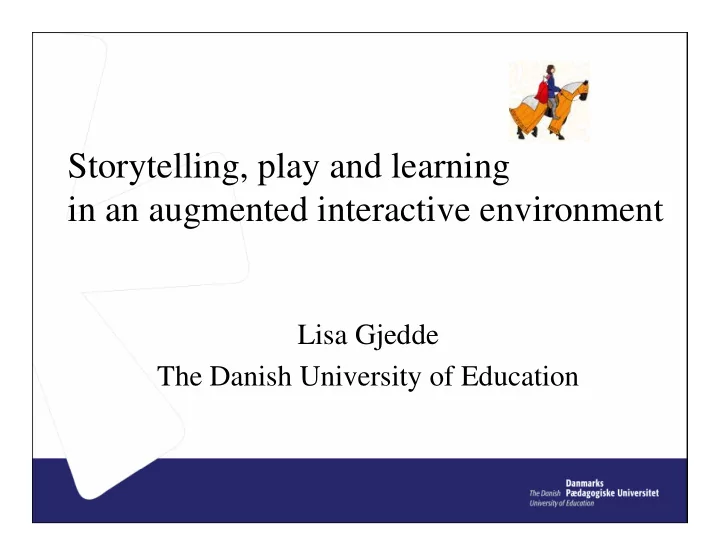

Storytelling, play and learning in an augmented interactive environment Lisa Gjedde The Danish University of Education
Background • R&D project developing a prototype of a narrative augmented interactive resource • Funded by the Danish Ministry of Education • Partnership between, 3 special needs schools, the National Knowledge center for Special Needs (VIKOM) and the Danish University of Education
Target group • Learners with multiple functional deficiencies aged 12-16 • Normally functioning young learners • Teachers • Parents and siblings
Project goals • Designing and reseaching a ressource that: • Enables the learners experience through accessible navigation, relevant content and activities and a stimulating narrative material • Is interesting for helpers and ordinary students as well • Can be used over a prolonged period of time • Can be used as a design-base for researching the learning and communication potentials
Empowering the learner • Story as universal communication tool • Experience of identity and value as a human being through story • Experience of choice and control • Agency • Complexity • Inclusion
Narrative as cognitive tool • “it is very likely the case that the most natural and the earliest way in which we organize our experience and our knowledge is in terms of the narrative form” (Bruner 1996: 121)
Stories and enculturation • Stories are fundamental to human communications and understanding of a culture. Through the stories of the culture we are enculturated. (Bruner 1996) the stories provides tools to help in the creation of meaning, at both personal and global levels
Narrative learning principles • Learning about causality and concepts • Enculturation • Hermeneutic processes • Literacy through symbols • Construction of meaning and construction of identity • Expressing choices and communicating
Design with narrative as pathway for learning • Frame narrative using animation • Side stories using video • Learner activities using games • Interactivity
Narrative, communication and identity • The role of communication in working with learners with multiple dysfunctions • Using story to develop a programme that can function as a platform for communication
Identity and choice making • Allowing the learners to deal with aspects of identity, through making choices • Providing learners’ with choice of more than two elements
Design process • User centred iterative design process, involving learners, teachers and special need consultants • Developing a relevant narrative content • Developing a design supporting a pervasive narrative • Augmented interface supporting switch access and voice-support, multiple points of entry and easily accessible menus
Augmenting the interface • Simple navigation • Multiple entry-points • Predictions for the choices • Scanning is optional allowing for use of switches and touch- screens and repeated prediction cycles • The scanning speed can be adapted to the learner in the set-up.
Story-based learning design • What are the implications of the complexity of narrative design and content in relation to communication and motivation for learning? • Can a narrative environment further collaborative as well as individual learning?
Metods • Action research • Classroom observations and case-studies • Interviews with teachers, special needs consultants, Involving the parents • Interviews with students using speech-machines and symbolcharts, laminated prints from the programme • Teachers writing log-books and doing video- observations
Exploring through narrative guidance • The learners are guided through the story following the main character and can explore interactive elements that are highlighted, using the scanning- function, making choices accessible to even severely challenged learners.
Demo
Video
Learning Scenarios • Programme used adressing the themes with physically anchored collaborative activities like: • Dressing up, Shield-making, music-making, cooking etc. • Programme used to frame excursion to medieval life center • Programme used for assesment of learners interests
Video
Pervasiveness of the Narrative • Setting up context and expectations through storytelling • Principle of coherence • All events and activities are within the story
Video
Narrative learning and inclusion • Inclusiveness – allowing for understanding relative to the students background • Multiple perspectives: allowing for multiple interpretations and constructions. • Multiple learning styles: allowing for different modes of storytelling and expression, based on visual, auditory or verbal competencies.
Narrative language and modes of expression • Communicating thoughts and feelings through choice making individually and collaboratively: • Narrative expression • Visual expression • Musical expression • Symbolic expression
Conclusions • A platform for communication • A complexity which enables: • Choices in relation to preferences, communicating aspects of identity to peers and teachers/helpers • Communication between learner and teacher/helper • Communication between the learners • Cultural learning in a classroom context
Thank you ! lg@dpu.dk
Recommend
More recommend